Intensity-Modulated PM-PCF Sagnac Loop in a DWDM Setup for Strain Measurement
Abstract
Featured Application
Abstract
1. Introduction
2. Theory
3. Proposed Sensor Network
4. Experimental Setup
5. Results and Discussion
5.1. Strain Response of the PM-PCF Sagnac Interferometer
5.2. Strain Response of the Intensity-Modulated DWDM PM-PCF Sagnac Loop Sensor
6. Conclusions
Author Contributions
Acknowledgments
Conflicts of Interest
References
- Chin, K.; Fang, Z.; Qu, R. Fundamentals of Optical Fiber Sensors, 1st ed.; John Wiley & Sons, Inc.: Hoboken, NJ, USA, 2012; pp. 1–6. [Google Scholar]
- Zhu, T.; Ke, T.; Rao, Y.; Chiang, K.S. Fabry–Perot optical fiber tip sensor for high temperature measurement. Opt. Commun. 2010, 283, 3683–3685. [Google Scholar] [CrossRef]
- Geng, Y.; Li, X.; Tan, X.; Deng, Y.; Yu, Y. High-Sensitivity Mach–Zehnder Interferometric Temperature Fiber Sensor Based on a Waist-Enlarged Fusion Bitaper. IEEE Sens. J. 2011, 11, 2891–2894. [Google Scholar] [CrossRef]
- Zhou, J.; Wang, Y.; Liao, C.; Sun, B.; He, J.; Yin, G.; Liu, S.; Li, Z.; Wang, G.; Zhong, X.; et al. Intensity modulated refractive index sensor based on optical fiber Michelson interferometer. Sens. Actuators B Chem. 2015, 208, 315–319. [Google Scholar] [CrossRef]
- Wo, J.; Wang, G.; Cui, Y.; Sun, Q.; Liang, R.; Shum, P.P.; Liu, D. Refractive index sensor using microfiber-based Mach–Zehnder interferometer. Opt. Lett. 2012, 37, 67–69. [Google Scholar] [CrossRef] [PubMed]
- Alwis, L.; Sun, T.; Grattan, K.T.V. Fibre optic long period grating-based humidity sensor probe using a Michelson interferometric arrangement. Sens. Actuators B Chem. 2013, 178, 694–699. [Google Scholar] [CrossRef]
- Chen, L.H.; Li, T.; Chan, C.C.; Menon, R.; Balamurali, P.; Shaillender, M.; Neu, B.; Ang, X.M.; Zu, P.; Wong, W.C.; et al. Chitosan based fiber-optic Fabry–Perot humidity sensor. Sens. Actuators B Chem. 2012, 169, 167–172. [Google Scholar] [CrossRef]
- López-Higuera, J.M.; Cobo, L.R.; Incera, A.Q.; Cobo, A. Fiber optic sensors in structural health monitoring. J. Lightwave Technol. 2011, 29, 587–608. [Google Scholar] [CrossRef]
- Hu, L.M.; Chan, C.C.; Dong, X.Y.; Wang, Y.P.; Zu, P.; Wong, W.C.; Qian, W.W.; Li, T. Photonic Crystal Fiber Strain Sensor Based on Modified Mach–Zehnder Interferometer. IEEE Photonics J. 2012, 4, 114–118. [Google Scholar] [CrossRef]
- Zhou, J.; Wang, Y.; Liao, C.; Yin, G.; Xu, X.; Yang, K.; Zhong, X.; Wang, Q.; Li, Z. Intensity-Modulated Strain Sensor Based on Fiber In-Line Mach–Zehnder Interferometer. IEEE Photonics Technol. Lett. 2014, 26, 508–511. [Google Scholar] [CrossRef]
- Liu, S.; Wang, Y.; Liao, C.; Wang, G.; Li, Z.; Wang, Q.; Zhou, J.; Yang, K.; Zhong, X.; Zhao, J.; et al. High-sensitivity strain sensor based on in-fiber improved Fabry-Perot interferometer. Opt. Lett. 2014, 39, 2121–2124. [Google Scholar] [CrossRef]
- Lima, H.F.; Antunes, P.F.; de Lemos Pinto, J.; Nogueira, R.N. Simultaneous Measurement of Strain and Temperature with a Single Fiber Bragg Grating Written in a Tapered Optical Fiber. IEEE Sens. J. 2010, 10, 269–273. [Google Scholar] [CrossRef]
- Wang, Y.-P.; Xiao, L.; Wang, D.N.; Jin, W. Highly sensitive long-period fiber-grating strain sensor with low temperature sensitivity. Opt. Lett. 2006, 31, 3414–3416. [Google Scholar] [CrossRef]
- Zhong, X.; Wang, Y.; Qu, J.; Liao, C.; Liu, S.; Tang, J.; Wang, Q.; Zhao, J.; Yang, K.; Li, Z. High-sensitivity strain sensor based on inflated long period fiber grating. Opt. Lett. 2014, 39, 5463–5466. [Google Scholar] [CrossRef] [PubMed]
- Frazão, O.; Baptista, J.M.T.; Santos, J.L. Recent Advances in High-Birefringence Fiber Loop Mirror Sensors. Sensors 2007, 7, 2970–2983. [Google Scholar] [CrossRef] [PubMed]
- Dong, X.; Tam, H.Y. Temperature-insensitive strain sensor with polarization-maintaining photonic crystal fiber based Sagnac interferometer. Appl. Phys. Lett. 2007, 90, 151113. [Google Scholar] [CrossRef]
- Han, Y.G. Temperature-insensitive strain measurement using a birefringent interferometer based on a polarization-maintaining photonic crystal fiber. Appl. Phys. B 2009, 95, 383–387. [Google Scholar] [CrossRef]
- Fu, H.Y.; Tam, H.Y.; Shao, L.-Y.; Dong, X.; Wai, P.K.A.; Lu, C.; Khijwania, S.K. Pressure sensor realized with polarization-maintaining photonic crystal fiber-based Sagnac interferometer. Appl. Opt. 2008, 47, 2835–2839. [Google Scholar] [CrossRef] [PubMed]
- Tang, Z.; Lou, S.; Wang, X. Experimental investigation on environmental stability of erbium-doped fiber laser based on Sagnac interferometer with a polarization-maintaining photonic crystal fiber. Opt. Laser Technol. 2018, 107, 186–191. [Google Scholar] [CrossRef]
- Qian, W.W.; Zhao, C.L.; Dong, X.Y.; Jin, W. Intensity measurement based temperature-independent strain sensor using a highly birefringent photonic crystal fiber loop mirror. Opt. Commun. 2010, 283, 5250–5254. [Google Scholar] [CrossRef]
- Zhao, C.-L.; Yang, X.; Lu, C.; Jin, W.; Demokan, M.S. Temperature-insensitive Interferometer using a highly birefringent photonic Crystal fiber loop mirror. IEEE Photonics Technol. Lett. 2004, 16, 2535–2537. [Google Scholar] [CrossRef]
- Frazão, O.; Baptista, J.M.; Santos, J.L. Temperature-Independent Strain Sensor Based on a Hi-Bi Photonic Crystal Fiber Loop Mirror. IEEE Sens. J. 2007, 7, 1453–1455. [Google Scholar] [CrossRef]
- Xiao, L.; Demokan, M.S.; Jin, W.; Wang, Y.; Zhao, C. Fusion Splicing Photonic Crystal Fibers and Conventional Single-Mode Fibers: Microhole Collapse Effect. J. Lightwave Technol. 2007, 25, 3563–3574. [Google Scholar] [CrossRef]
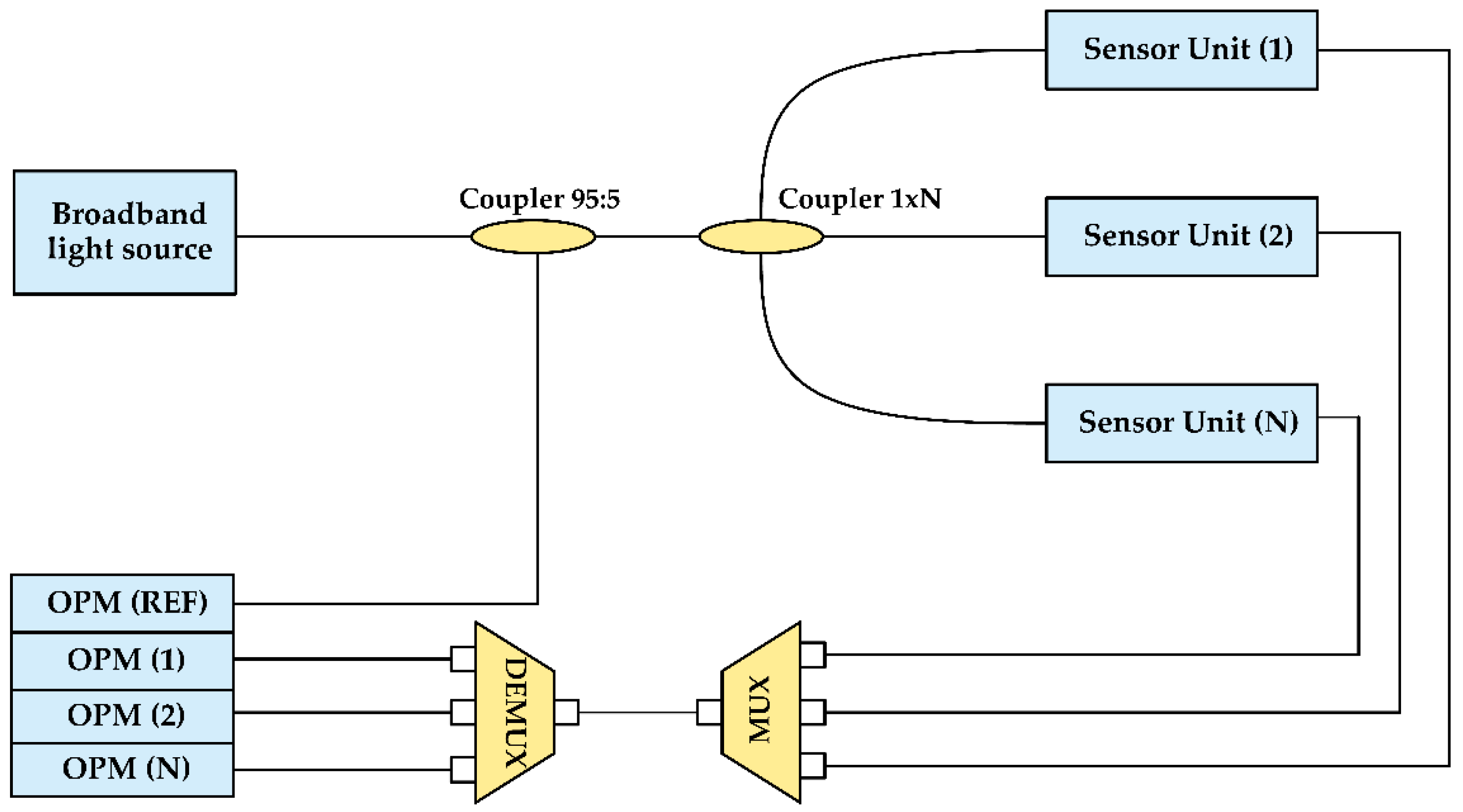
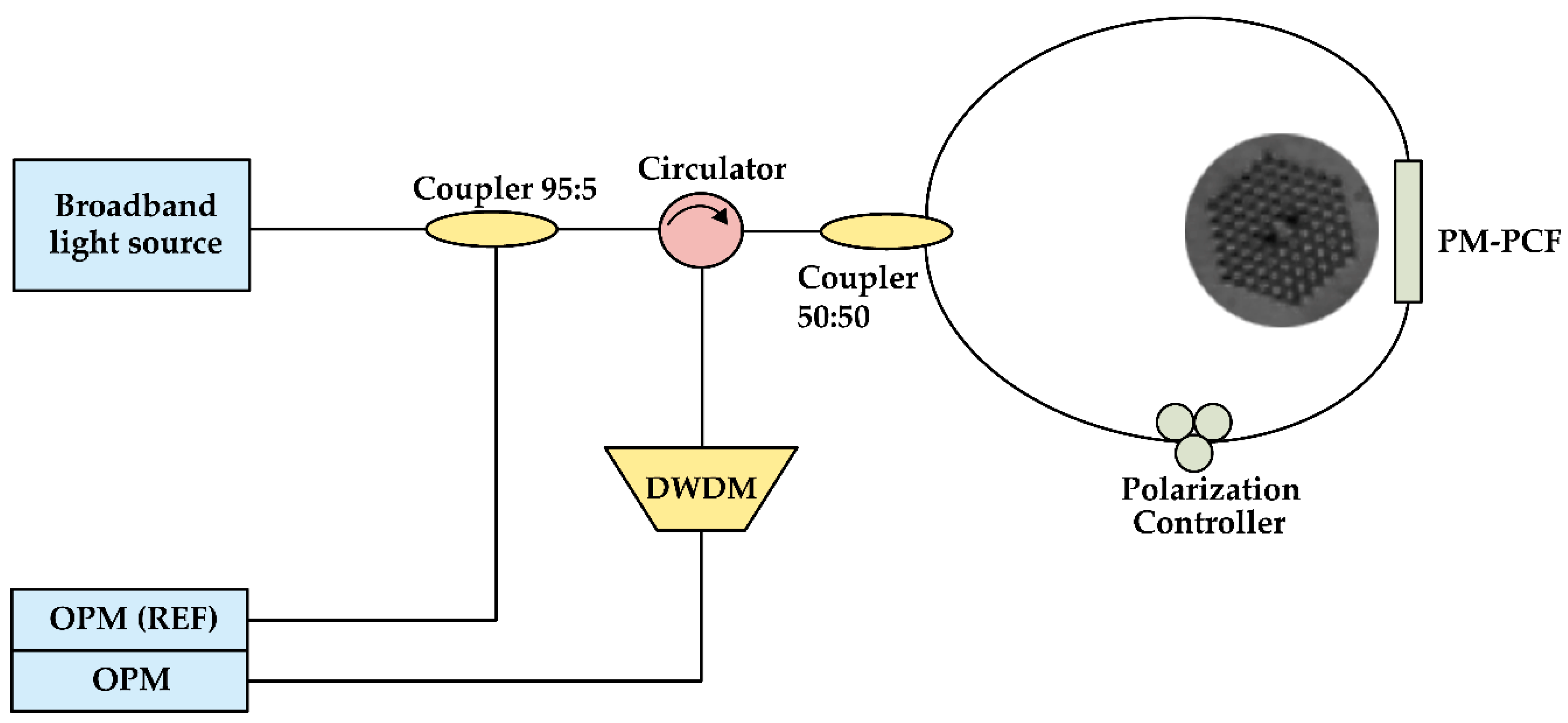
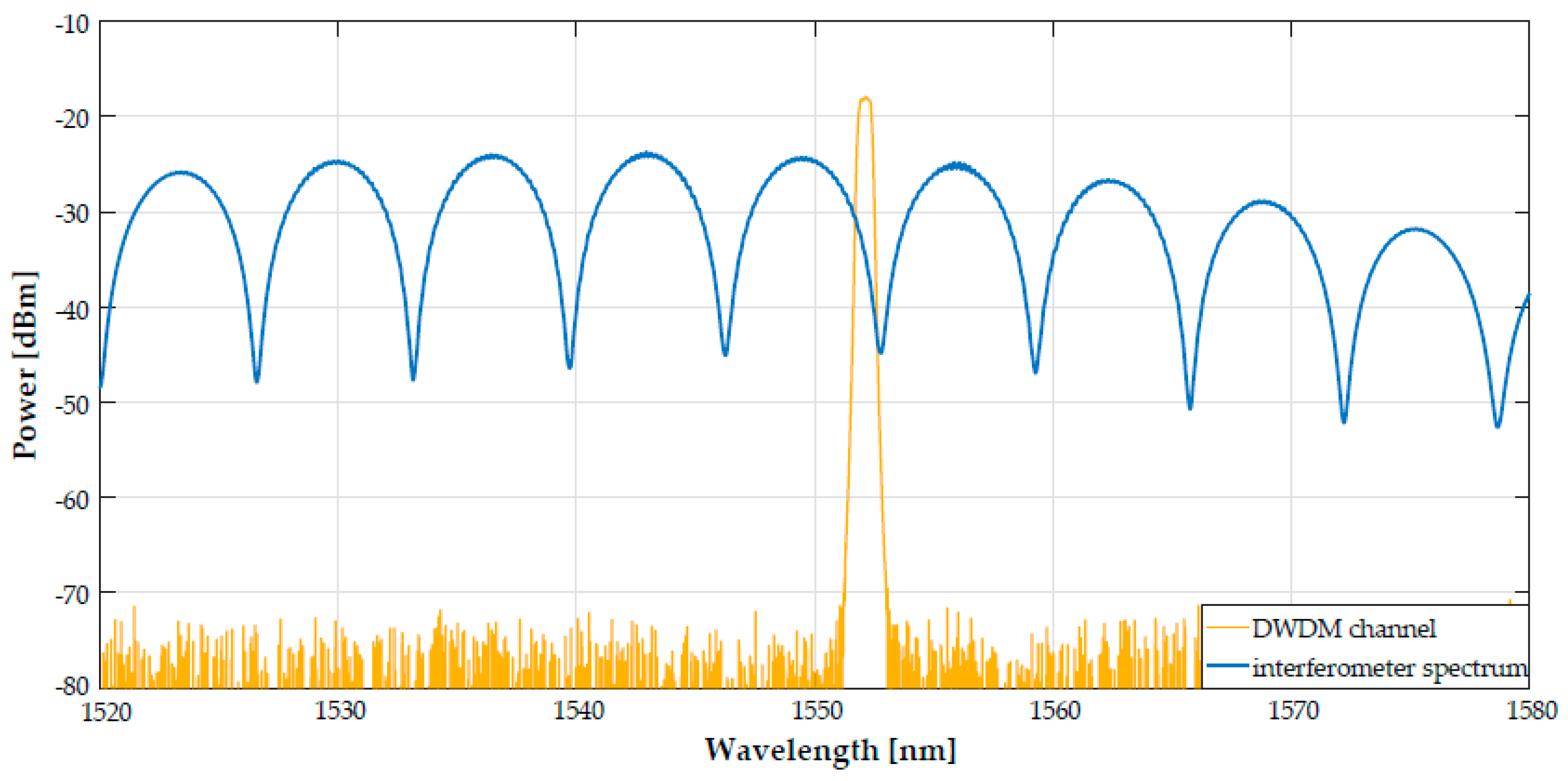
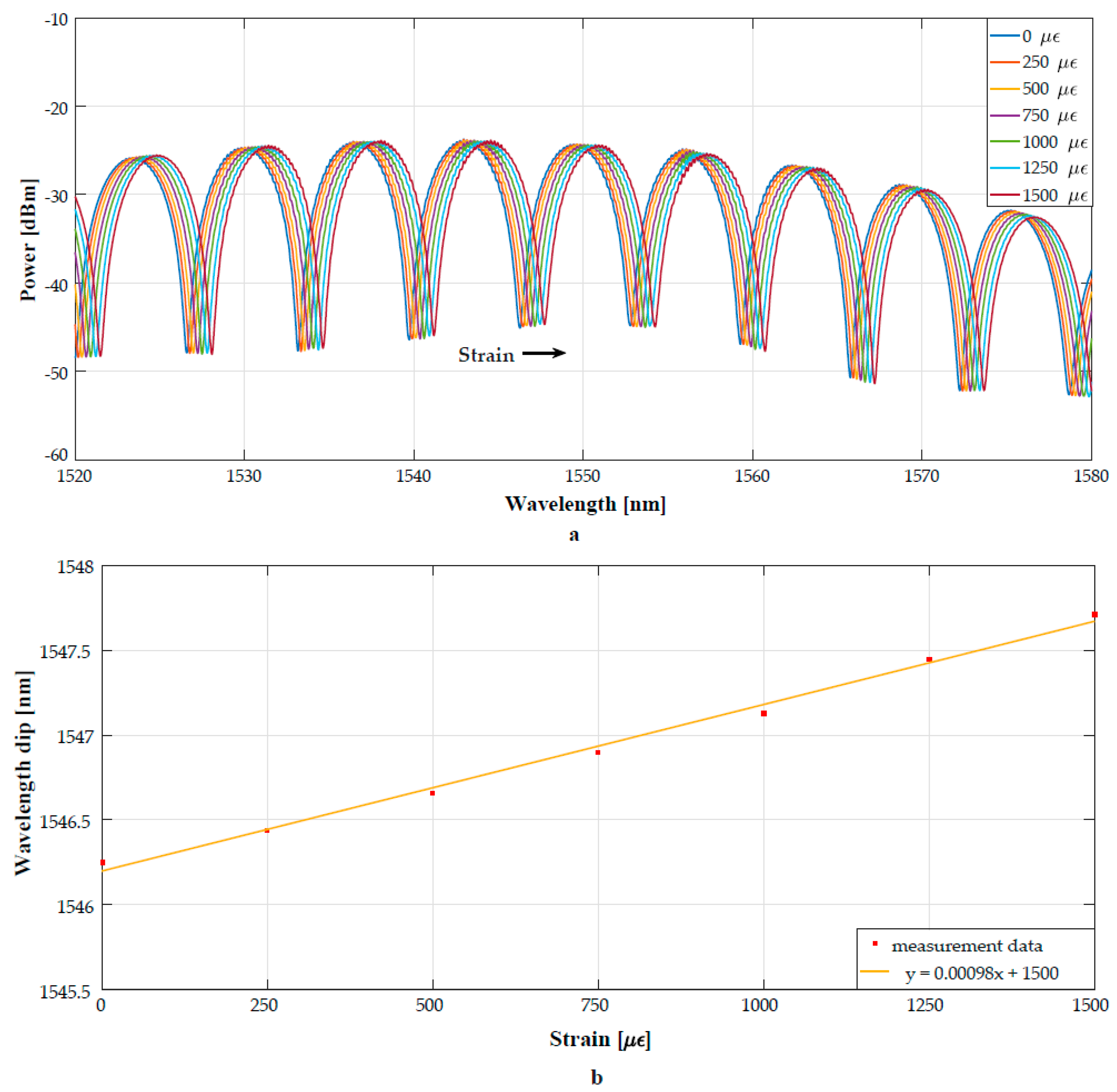
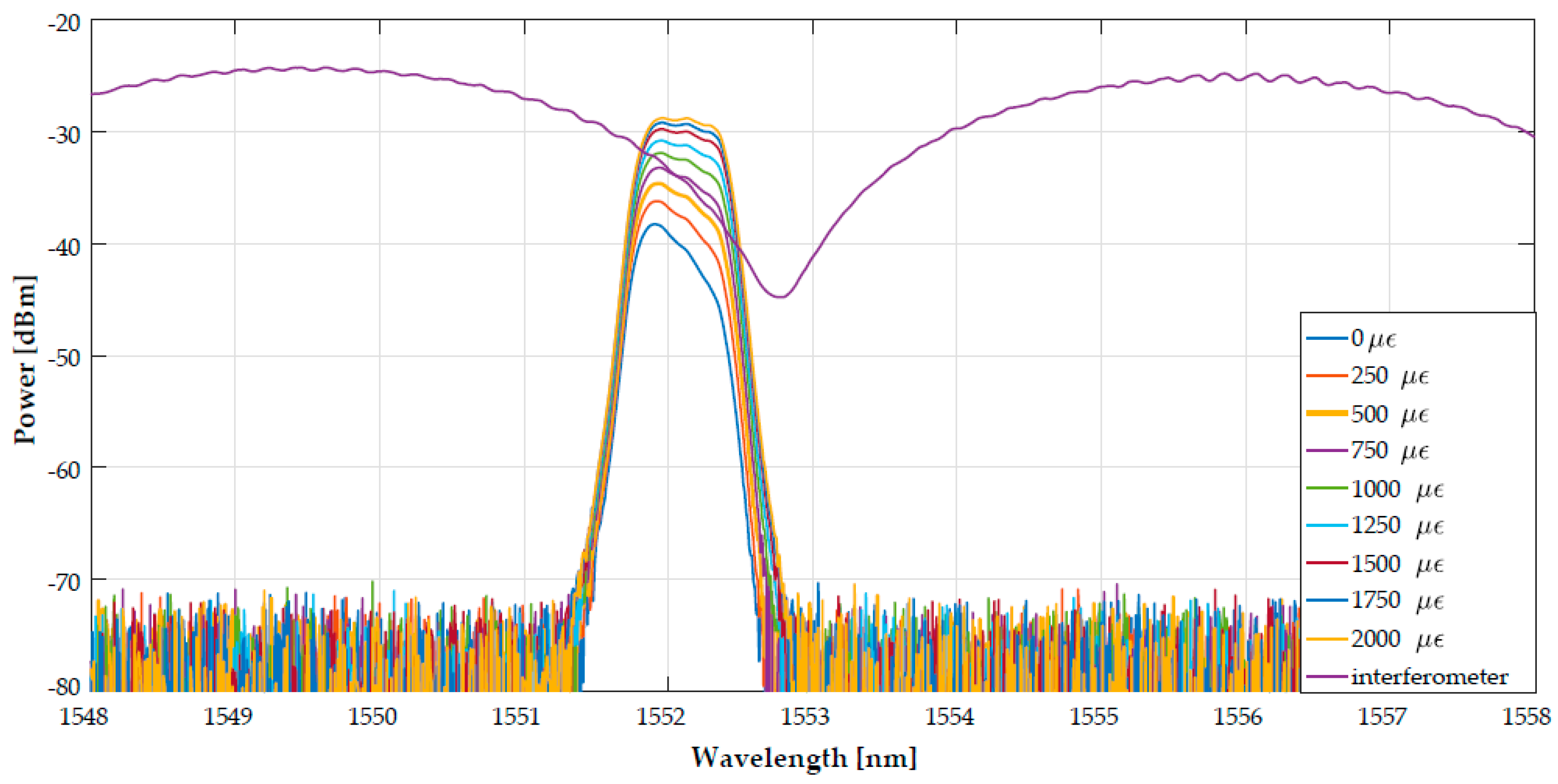
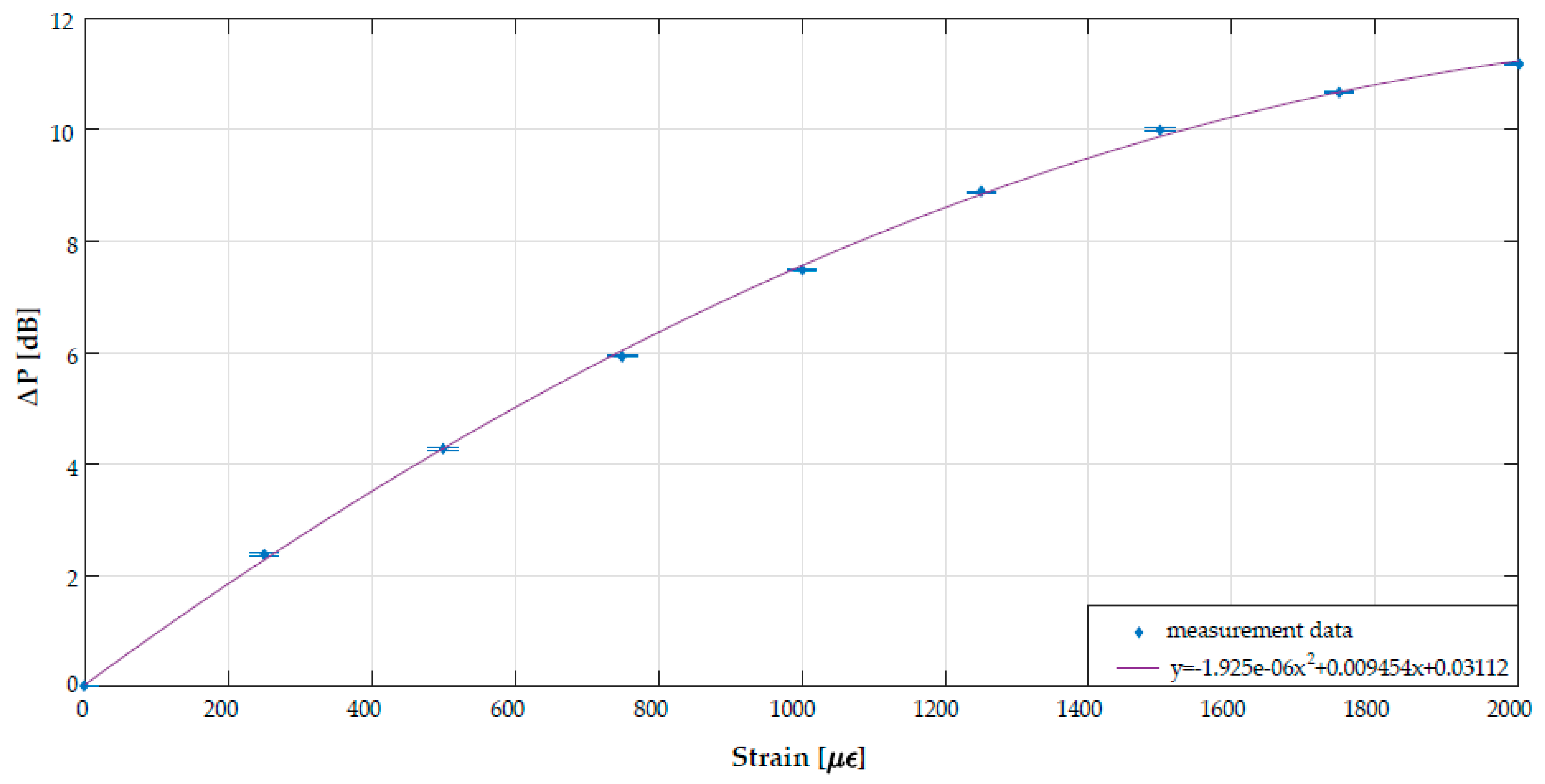
| Components of Sensor Setup | Parameters |
|---|---|
| Broadband light source (Thorlabs) | Superluminescent light emitting diode, λpeak = 1544.4 nm, FWHM = 45.5 nm, Noise: <0.1% |
| Optical power meter (Grandway) | InGaAs detector, resolution: 0.01 dB, measuring range: −70 to +10 dBm (1550 nm) |
| Polarization maintaining photonic crystal fiber (PM-1550-01, Thorlabs) | Core diameter 6.3/4.4 ± 0.5 µm, outer cladding 125 ± 5 µm, coating diameter 240 ± 10 µm, length—40 cm, attenuation ≤3 dB/km (1550 nm), birefringence: ≥4·× 10−4. |
| Fiber coupler (Cellco) | Single mode, 1 × 2, split ratio: 50:50 |
| Fiber coupler (Cellco) | Single mode, 1 × 2, split ratio: 95:5 |
| Fiber circulator (Cellco) | 3-Port circulator, operating wavelength range: 1520–1580 nm |
| Dense wavelength division multiplexer (DWDM) (Fiberon) | Channel spacing: 100 GHz, transmission insertion loss: typical—1.2 dB, transmission isolation: 28 dB |
© 2019 by the authors. Licensee MDPI, Basel, Switzerland. This article is an open access article distributed under the terms and conditions of the Creative Commons Attribution (CC BY) license (http://creativecommons.org/licenses/by/4.0/).
Share and Cite
Mądry, M.; Alwis, L.; Bereś-Pawlik, E. Intensity-Modulated PM-PCF Sagnac Loop in a DWDM Setup for Strain Measurement. Appl. Sci. 2019, 9, 2374. https://doi.org/10.3390/app9112374
Mądry M, Alwis L, Bereś-Pawlik E. Intensity-Modulated PM-PCF Sagnac Loop in a DWDM Setup for Strain Measurement. Applied Sciences. 2019; 9(11):2374. https://doi.org/10.3390/app9112374
Chicago/Turabian StyleMądry, Mateusz, Lourdes Alwis, and Elżbieta Bereś-Pawlik. 2019. "Intensity-Modulated PM-PCF Sagnac Loop in a DWDM Setup for Strain Measurement" Applied Sciences 9, no. 11: 2374. https://doi.org/10.3390/app9112374
APA StyleMądry, M., Alwis, L., & Bereś-Pawlik, E. (2019). Intensity-Modulated PM-PCF Sagnac Loop in a DWDM Setup for Strain Measurement. Applied Sciences, 9(11), 2374. https://doi.org/10.3390/app9112374






